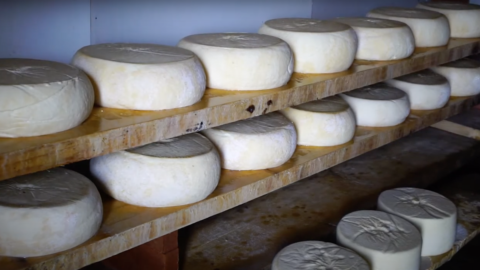A blue cheese that recalls the great tradition of Piedmontese blues. It's about the Toma di Lanzo, a cheese made from whole raw cow's milk, with a semi-hard pressed texture which can be semi-fat or fat and for which the Valli di Lanzo Consortium has prepared a production specification. This cheese is produced in small company dairies in the Valli di Lanzo or in the mountain pastures, through the ancestral rite of transhumance: the shepherds spend the winter in the farmhouses on the plains around Turin and in the summer they go up, with their herds, to the high pastures of the valleys where the cows feed on the plant essences and flowers of mountains, giving the cheese a unique flavour.
Many don't know it, but Toma di Lanzo is the protagonist of a regional exhibition held in Usseglio, now in its 26th edition. An ideal event for mountain and good food lovers in search of local gastronomic and artisan excellence.
History
The first news of this cheese dates back toRoman imperial era: around 150 AD when the gens Vennonia, a powerful Roman-Turin family, sent their slaves to pasture in Val d'Ala, where they produced cheese and butter. The first product information on the cheese produced in the Valli di Lanzo dates back to 1477, when the Vercelli doctor Pantaleone da Confienza wrote about this toma and the other Piedmontese toma. At that time cheese was consumed almost exclusively by the lower classes who used it to season other foods instead of more expensive spices. Toma di Lanzo is subsequently mentioned in several documents, among which it is good to remember the book "Voices and things of the old Piedmont", written by Alberto Virgilio in 1917 and since then, this cheese has commonly been known as Toma di Lanzo.
However, Toma di Lanzo has traditional characteristics which in part differ from those established by the PDO del Piedmontese cheese.
Production and characteristics of Toma di Lanzo
The raw milk from two milkings – in which the first, the evening one, is partially skimmed – is heated to a temperature of 36-37° and added with veal rennet. Coagulation occurs in about 10-60 minutes.
The curd is broken to the size of a grain of rice with a whisk. It is then extracted with cloths, kneaded and pressed by hand. Another pressing follows, this time with weights, for 24 hours. There salting the following is carried out exclusively dry and it is a phase that lasts 10-15 days in which the cheese will be turned several times on both sides. Finally, the cheeses are brought to the premises for the seasoning at medium-low temperature (5-10 degrees with 85% humidity) for a period ranging from 20 to 90 days.
The rind is quite soft, elastic, thin, straw-coloured, darker according to the aging time. The texture is soft, elastic, light straw-coloured, with small, evenly distributed holes.
Combinations in the kitchen
It is consumed in purity, also used for the concia polenta, in which the toma is placed when the polenta is almost finished and a considerable amount of butter has already been added. Also excellent pairing with Piedmont salami. It is rather sought after as an ingredient for first courses such as risotto (toma rice in which the latter is creamed in abundance making the risotto extremely stringy), soups and other cheese-based recipes. It goes well with red wines of various types, of alcohol content, depending on the ageing.





